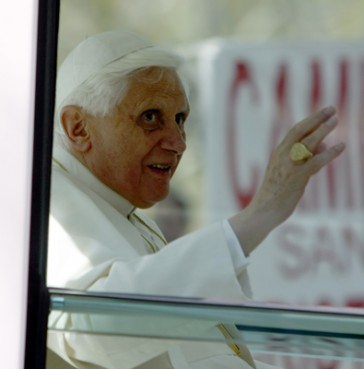
(RNS) Pope Benedict XVI will face a more hostile audience when he visits the United Kingdom next week than he did when he visited Washington and New York, seen here along Fifth Avenue, in 2008. Religion News Service file photo by Hilton Flores/The Staten Island Advance.
LONDON (RNS) Inside Westminster Cathedral, the mother church of Catholicism in England and Wales, bronze plaques commemorate the leaders of English Catholicism since the year 314.
The plaques are a pointed reminder that the Catholic Church is by far Britain’s oldest existing institution, preceding even the monarchy by at least half a millennium.
The cathedral, however, didn’t open until 1903, and is still very much a work in progress — much like the small Catholic flock that Pope Benedict XVI will meet when he arrives Thursday (Sept. 16) for a four-day official state visit to the United Kingdom.
British Catholicism is, like the cathedral, a relatively youthful institution with an ancient heritage. While the bottom half of the cathedral is covered with multicolored marbles and glittering mosaics, its upper walls and vaults are bare brick, awaiting decoration as finances permit.
The Roman Catholic Church in Britain might seem to be of marginal interest to the pope; Britain’s 5.3 million Catholics represent less than 10 percent of one of Europe’s most secular countries, and a mere 0.5 percent of Benedict’s worldwide flock.
Yet their experience of marginalization — of long survival as an often-embattled minority — is what makes British Catholics especially prized recruits for Benedict’s campaign to re-evangelize the post-Christian West.
Since the early 19th century, when British Catholics regained the religious freedom they had lost in the Protestant Reformation three centuries earlier, their church has survived through foreign immigration, first from Ireland and lately from more distant lands, including Eastern Europe and Latin America.
At St. Anne’s Church, traditionally an Irish congregation in London’s Bethnal Green neighborhood, Brazilian ex-pats now worship in Portuguese to the accompaniment of samba drums.
Thanks in part to immigration, an estimated 1 million British Catholics attend Mass every week. At less than 19 percent, the rate is low by American standards, yet much larger than the reported 1 percent of (Anglican) Church of England members in the pews each week.
The exotic element in Catholic worship here coexists with a striking degree of traditionalism. At Our Lady and the English Martyrs in the university town of Cambridge, one of the six well-attended Sunday Masses is in Polish; another is in Latin.
On a recent weekday afternoon, two dozen people filled the London cathedral’s Chapel of the Blessed Sacrament for a time of Eucharistic adoration, a devotional practice that fell largely out of use in Western countries in the late 20th century. Several of the women in the group wore veils, and a few prostrated themselves on the marble pavement.
Such fidelity to tradition is a legacy of centuries of official persecution, which over time reduced the Catholic population to a die-hard core. More recently, Anglican converts seeking refuge from their church’s theological liberalism, tolerance of homosexuality and female clergy have added to the ranks of doctrinal and liturgical conservatives.
Of course, not all British Catholics are conservatives — nor enthusiastic supporters of Pope Benedict.
British Catholics include a prominent and vocal progressive wing, many of whom read or write for the prestigious weekly magazine The Tablet. The best-known member of this group is former Prime Minister Tony Blair, who converted to Catholicism in 2007 but then publicly distanced himself from Benedict’s teachings on homosexuality.
The official church booklet distributed for the pope’s visit notably avoids such contentious issues as sexual and medical ethics, and focuses instead on progressive aspects of Catholic social teaching and the church’s charitable and educational contributions.
The pamphlet was produced in close consultation with the British government, and might seem an attempt to avoid controversy during the papal visit — confirming complaints by conservative observers that the Catholic hierarchy is reluctant to follow the pope’s lead in confronting mainstream culture on divisive questions.
But according to Austen Ivereigh, a journalist who served as press secretary for retired London Cardinal Cormac Murphy-O’Connor, the bishops’ communications strategy dovetails with the pope’s own priorities, especially his defense of the church’s essential role in modern society.
By highlighting the importance of religious institutions to “civil society,” the pope will also subtly reaffirm his moral teachings, Ivereigh says.
That could become especially clear on Saturday (Sept. 18), when Benedict visits a London home for the elderly — an unusual stop for an international papal trip. Ivereigh thinks the visit could have implications for current British debates on end-of-life issues.
“The sight of an 83-year old pope embracing the aged,” Ivereigh says, “will send a stronger message about assisted suicide than any verbal statement could.”




